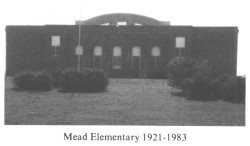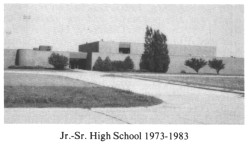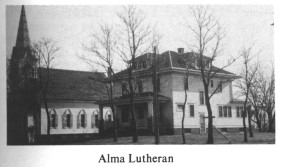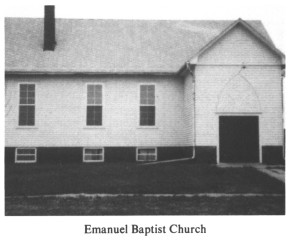 |
MARIETTA PRECINCT |
ALMA LUTHERAN CHURCHThe Alma Evangelical Swedish Lutheran Church was formally organized on Wed., Jan. 5, 1870. On that day, seven years before the coming of the railroad, or the village of Alvin (Mead), a group of eighteen adults and five children met in the home of Mr. and Mrs. John A. Allmen. Others present were: Pastor S.G. Larson, Mr. and Mrs. John Swenson, Ferdinand Allmen, Mr. and Mrs. John Hult and child, Mr. and Mrs. Andrew Larson and child, John Matson, Mr. and Mrs. August Nygren and three children, Andrew Hallner, Charles Monteen, Otto Hecklander, Nels Berggren, John Gibson and Sven Hedenskog. Two months later the congregation numbered 55 communicants and 16 children, all considered charter members. Alma was the second of six Swedish congregations in Nebr. which Pastor Larson was to establish. He was an emigrant (1858 Illinois), a homesteader in his own right (two miles south of Mead in early 1869), and a true pioneer and a missionary of his church (Augustana Swedish Lutheran). He believed the homesteading Swedes should locate in groups so that schools and churches could be organized to better serve their needs. Alma called S.G. Larson to be their first pastor. The congregation, recognizing his other responsibilities asked him to conduct only one service a month. The first church was started in 1871 in the northeast corner of Sec. 4-14-8 on land generously donated by John Clauson where the Alma cemetery is still located. Severe economic conditions prevented completion of the building until 1874. By that time the congregation numbered well over 200 adults and children. A parsonage was built in 1879 on 40 acres of land purchased from the railroad and located across the road east of the church. This property was sold in 1884 when the congregation decided to relocate in the new village of Mead. The new parsonage was built on a block of land kindly donated by Lars Anderson. Two years later (1886), a new church (at a cost of $7000), still in use today, was built on the same block. A basement was added in 1920. The first church was sold and moved to a farm one mile east of Mead. Horse barns were then built south of the new parsonage. Those who used them paid a fee for an assigned stall. During the first 45 years the language used at services of the congregation was Swedish. During the decade 1915-1925, the change was gradually made to English. On Jan. 1, 1963 Augustana Synod (and this congregation) became part of the Lutheran Church in America. The Alma congregation, now 113 years old, is today being served by its fifteenth pastor, Keith M. McKay. Nine sons of the congregation have entered the ministry: Franz Sard, Frank Anderson, David Vikner, Rudolph Samuelson, Roy Carlson, Carl Samuelson, Kenneth Dale, Stanley Ecklund and Roy Lund. FIRST BAPTIST CHURCHOn Feb. 2, 1889, eighteen members of the Estina Swedish Baptist Church who lived in the Mead area, met at the Methodist church to organize what became known as the First Swedish Baptist Church of Mead. The charter members were: Mr. and Mrs. Bengt Johnson, Mr. and Mrs. B.A. Peterson, Mr. and Mrs. Andrew Wicklund, Mr. and Mrs. L.E. Lund, Mr. and Mrs. A.F. Anderson, Mr. and Mrs. C.P. Johnson, Sophia Johnson, Ida Johnson, Edla Johnson, Albert Peterson, John O. Anderson and Hulda Swanson. On Feb. 5, 1889, at the first business meeting a decision to erect a church building 24'x40'x14' at 2nd and Vine was made; and in Sept. of 1889 the church was completed and dedicated. Rev. Hayland from Weston supplied the pulpit twice a month, and prayer meetings and Sunday School began. The Mission Circle (Ladies Aid) also organized in 1889 and continued through the years of the ministry of the church. The parsonage was built just north of the church in the spring of 1892. Rev. John Olander was pastor at this time. About 1908 this parsonage was sold and a larger one purchased. Because it was not satisfactory, it was torn down and a modern home built. It remains today in the same location, 119 S. Elm. In the early 1900's a new problem began to emerge. Some of the new members were not Swedish, so the question arose as to which language to use, especially in Sunday School. For a few years both languages were used, until finally all services were in English. The church building no longer provided the room needed, and a decision was made to remodel. Early in 1914 the work began. On Mar. 13, 1916, the building, valued at $13,500, was dedicated. Rev. C.R. Osbeck was pastor. When the U.S. Government appropriated the land south of Mead for the Ordnance Plant in 1941, many of the members of the church relocated in other areas, making it difficult for the remaining members to support a church. They decided to disband in 1947, and their building was sold to the Mission Covenant Church in 1948. Many of the remaining members of the Baptist Church united with the Covenant Church. During these years, C.N. Thomas, R.C. Butler, and Dwight Neville served as pastors.
MEAD EMANUEL BAPTIST |
MARIETTA PRESBYTERIAN |
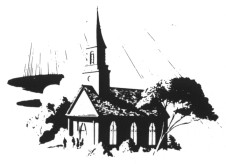 |
page 88
| Back | Contents | Next |
The Saunders County NEGenWeb Project
